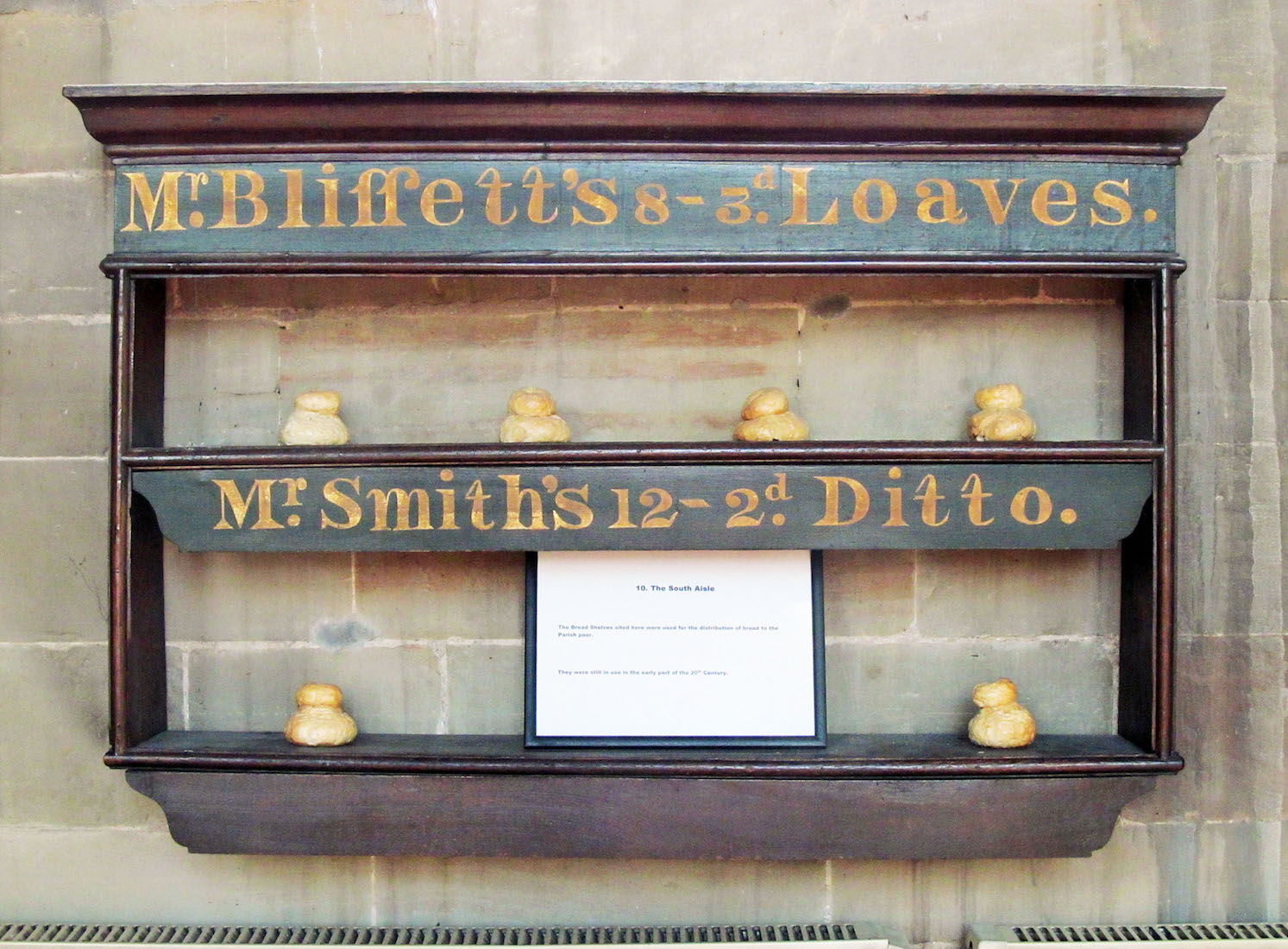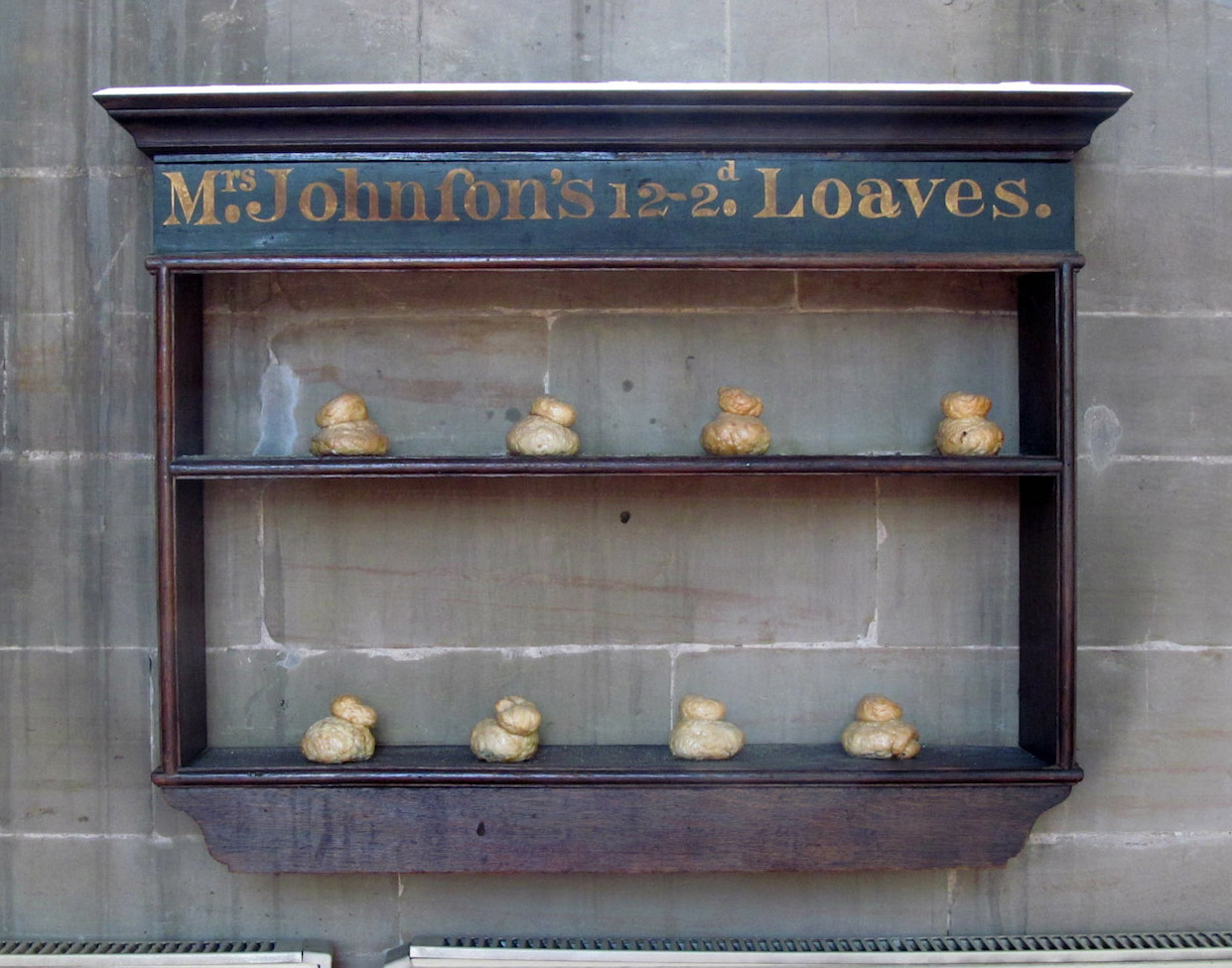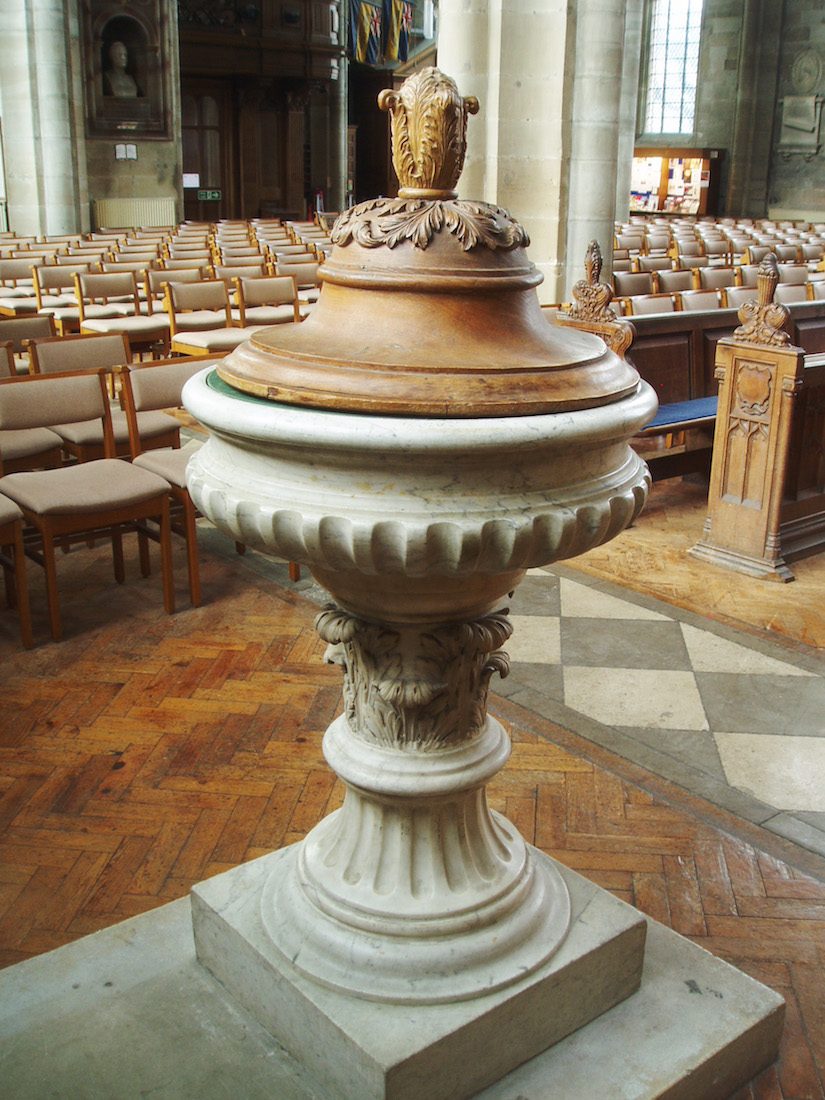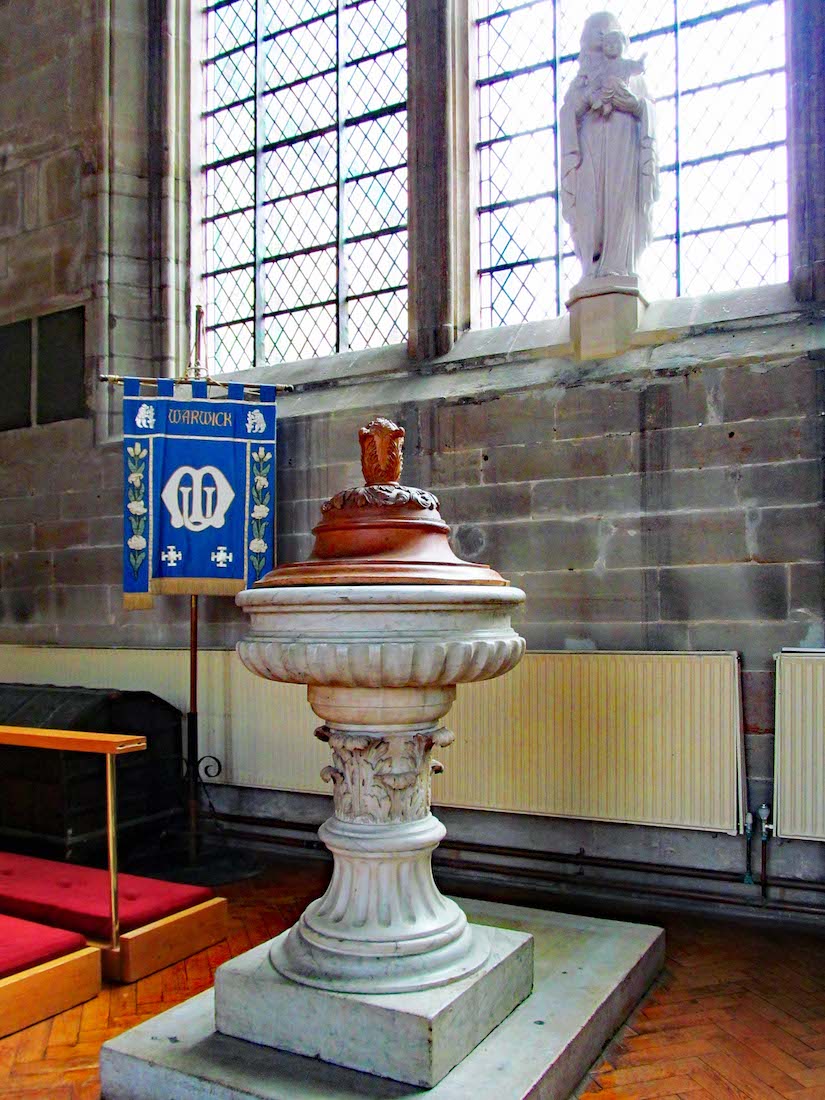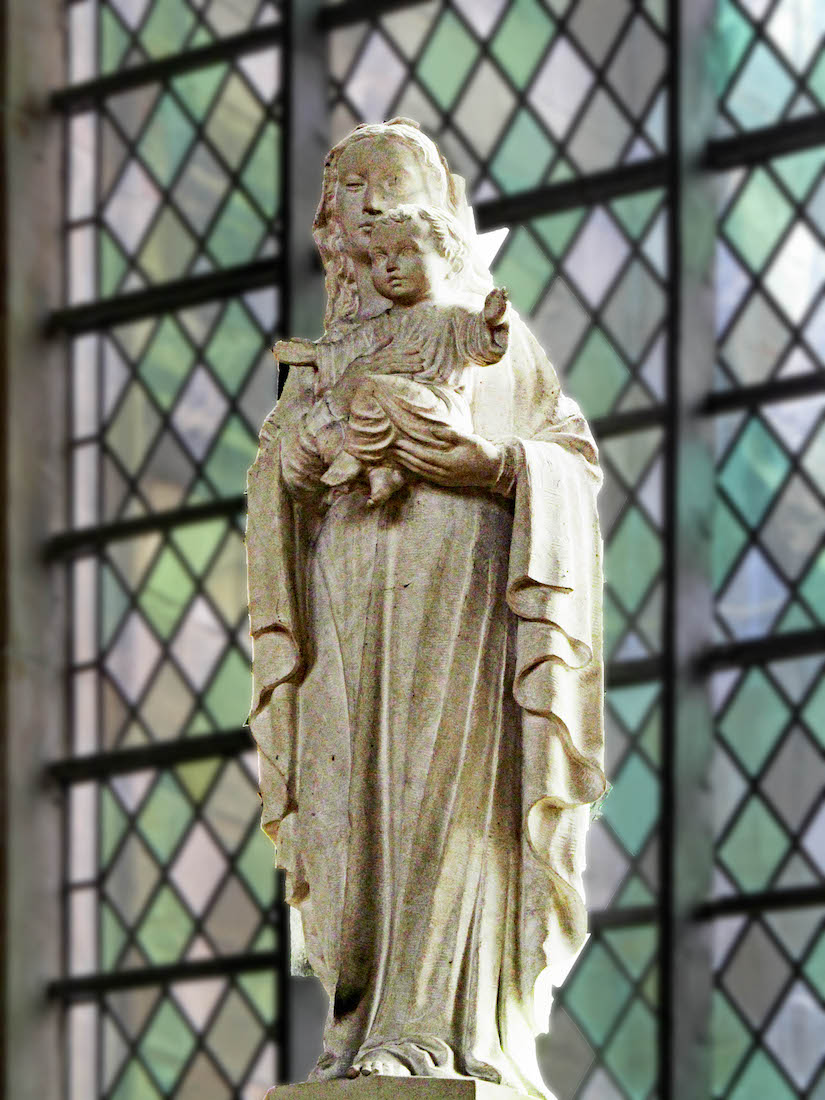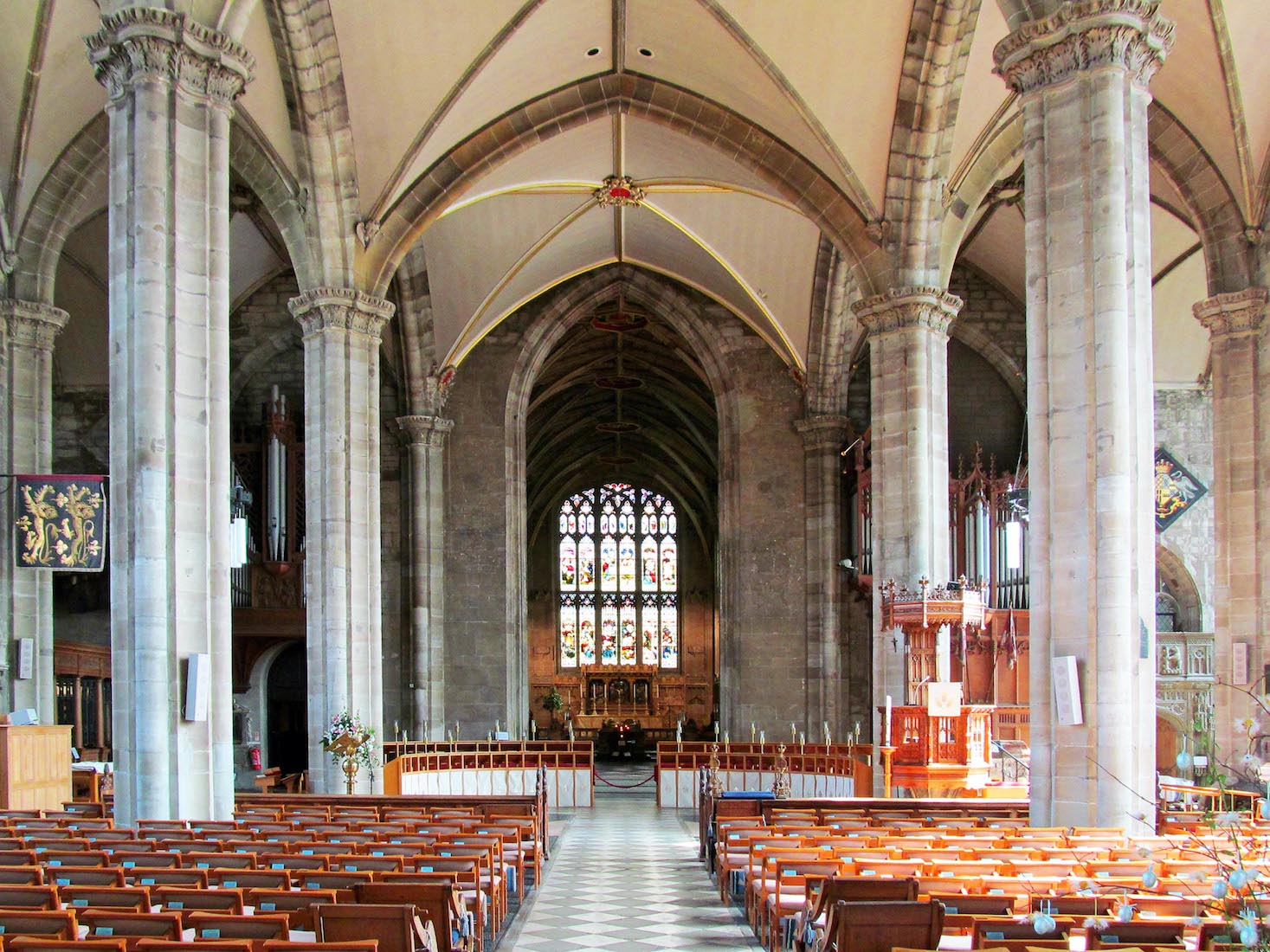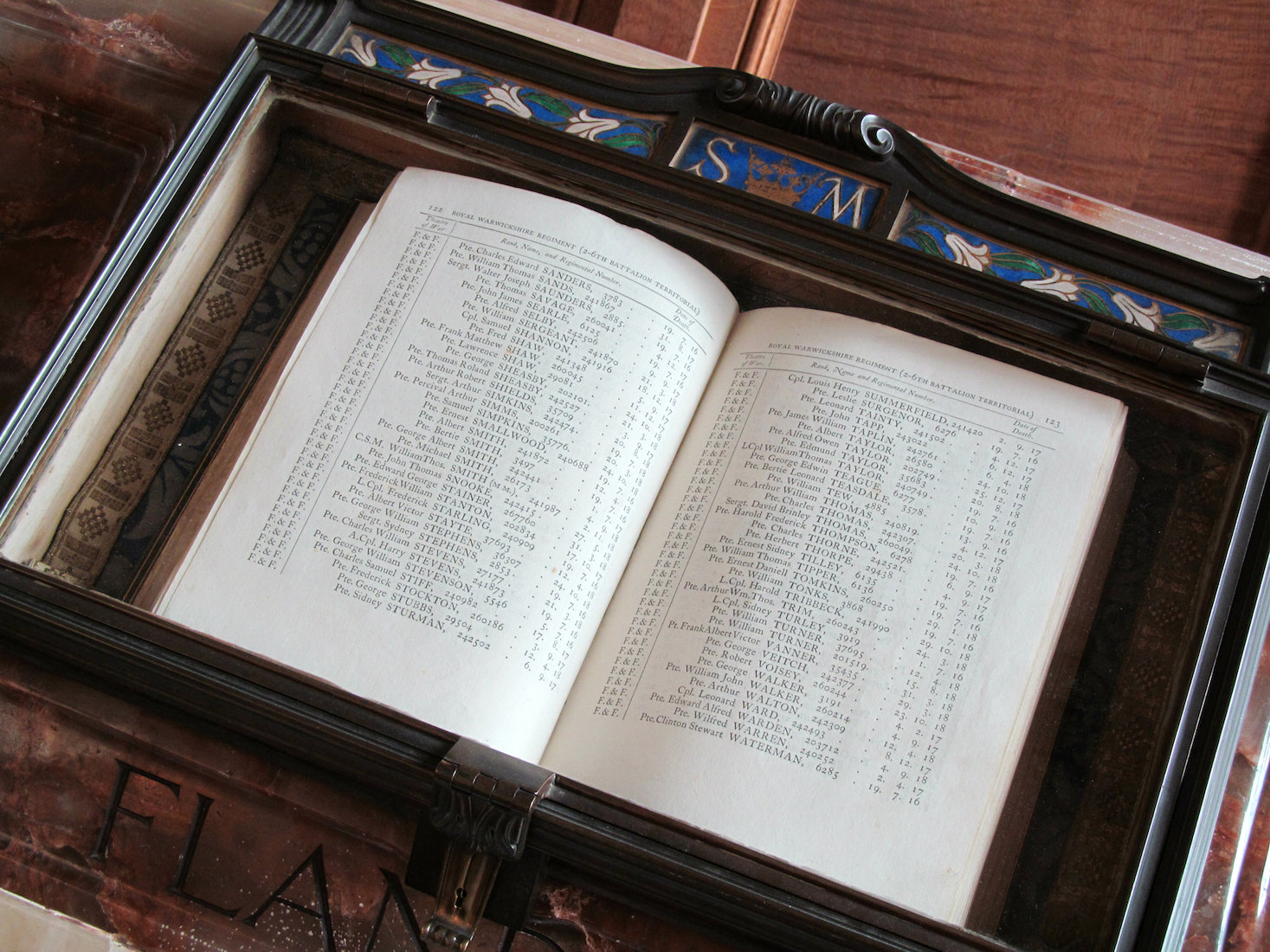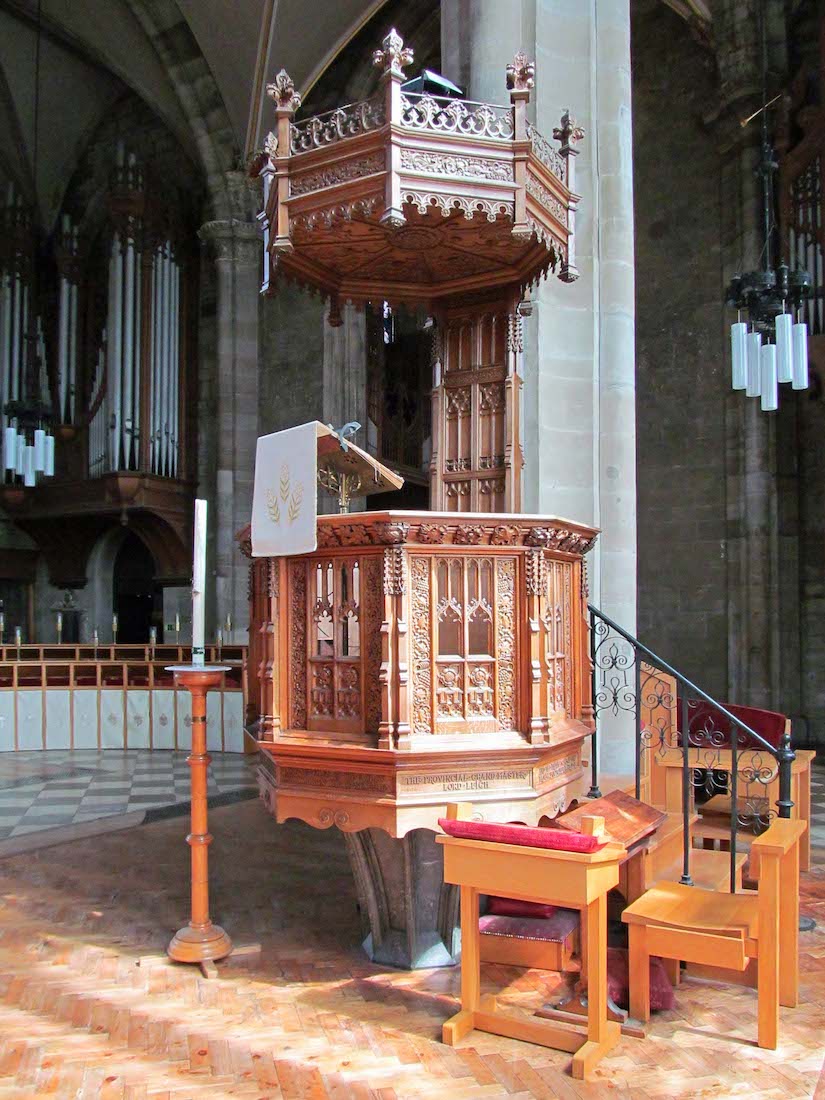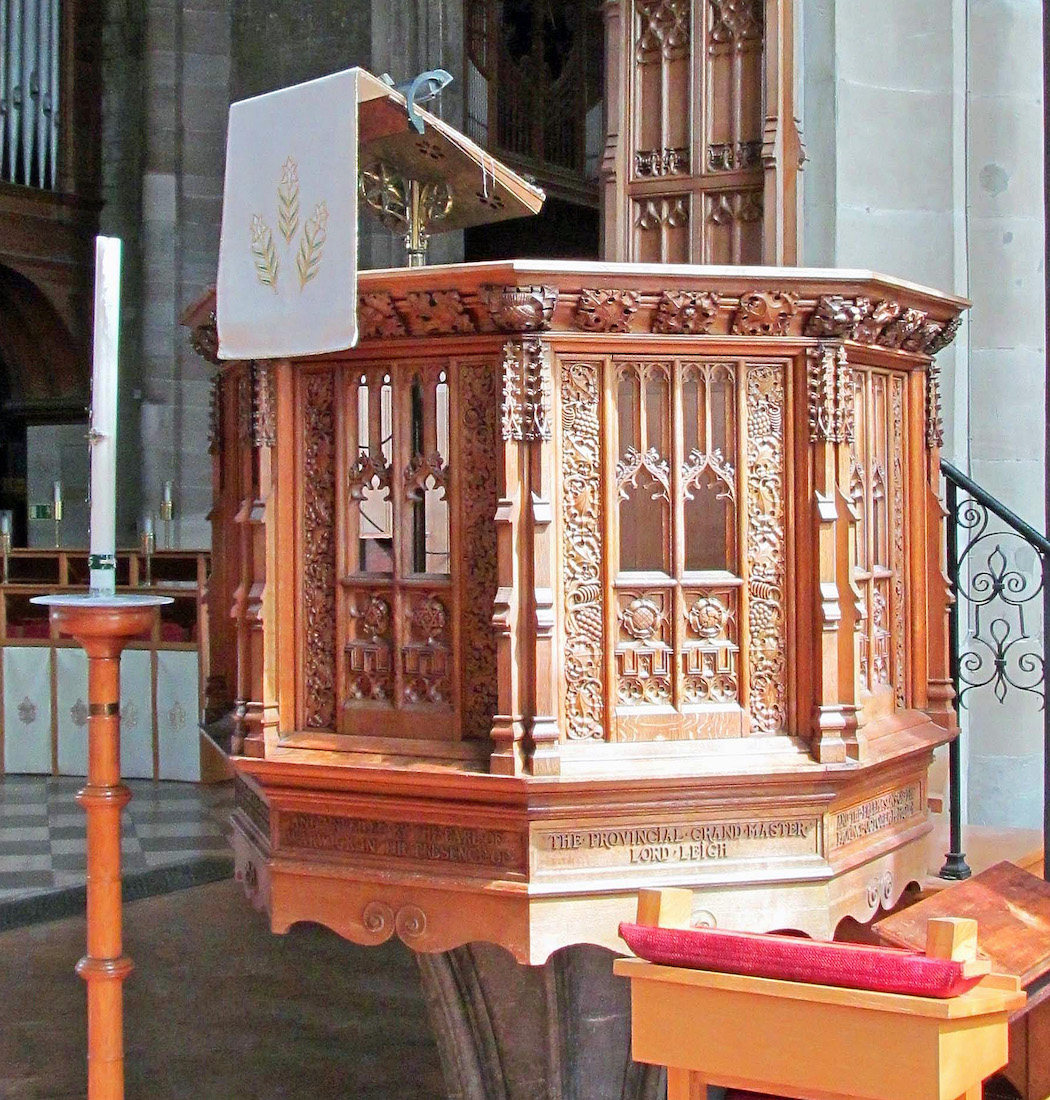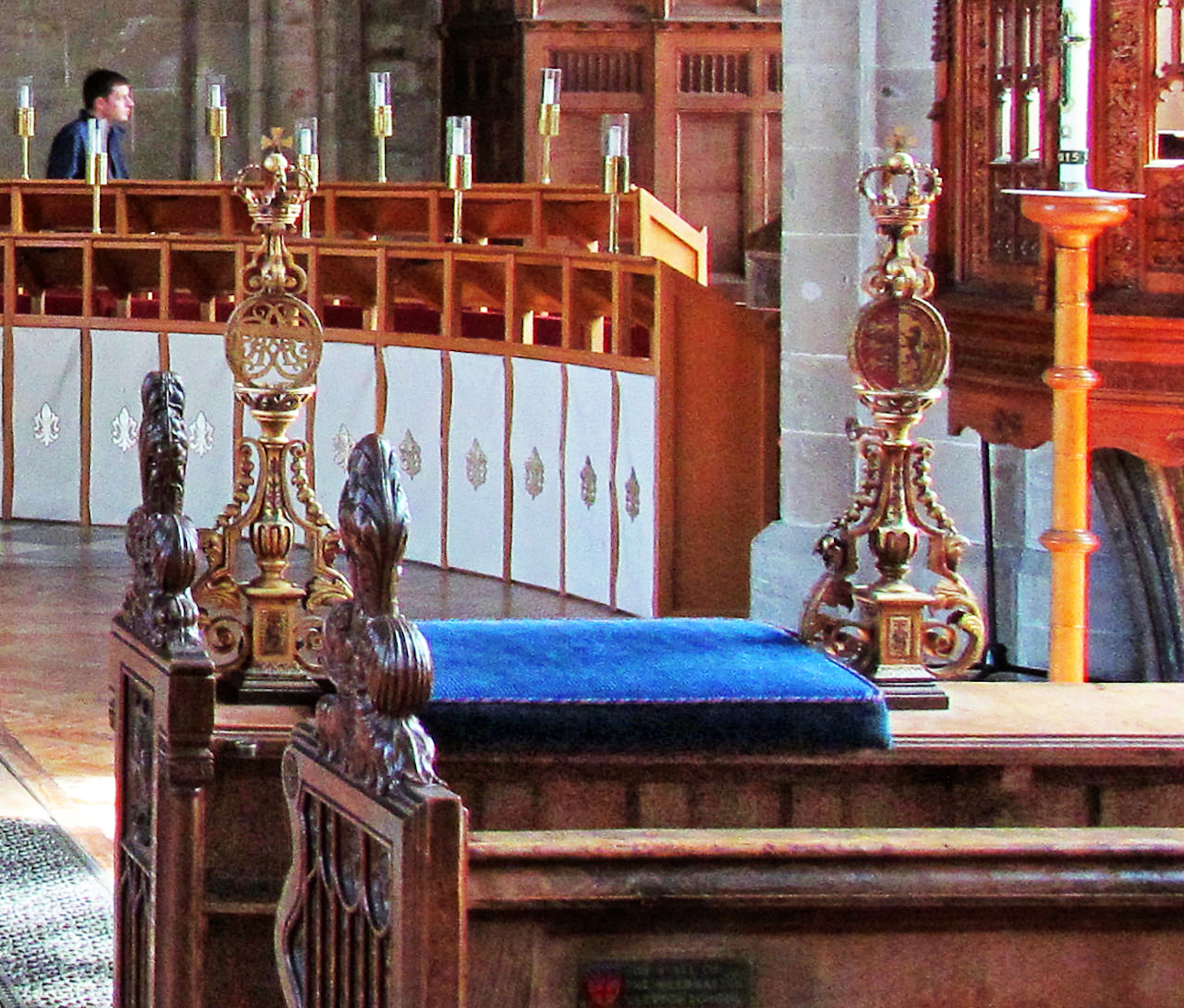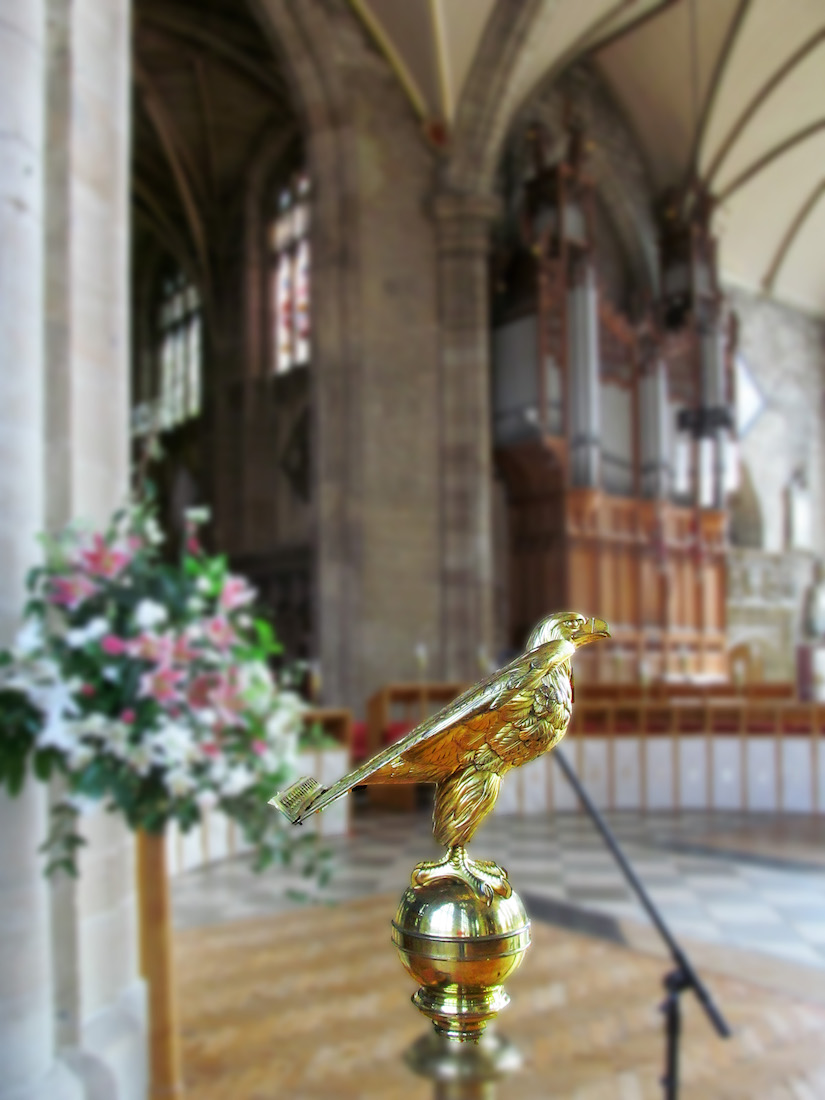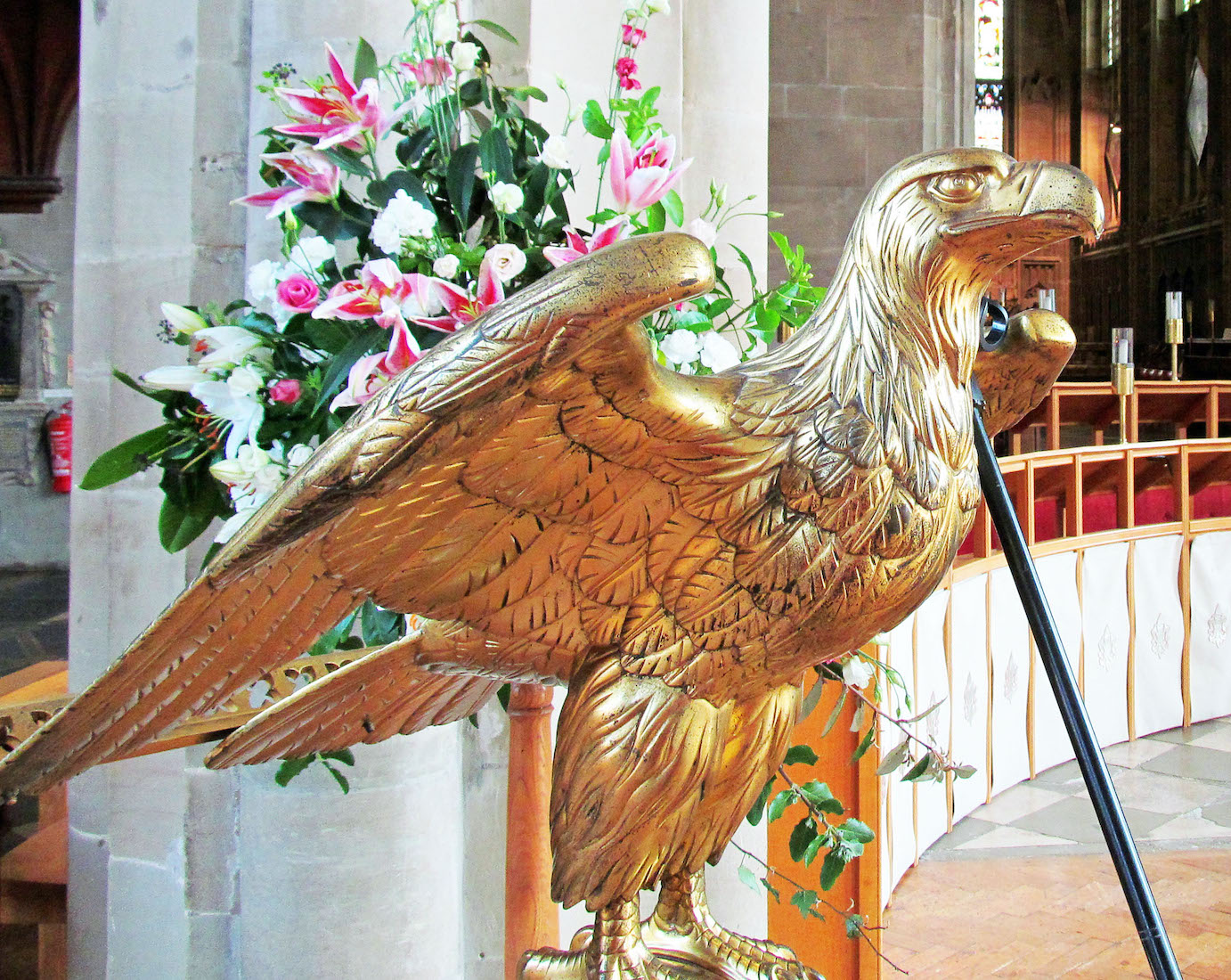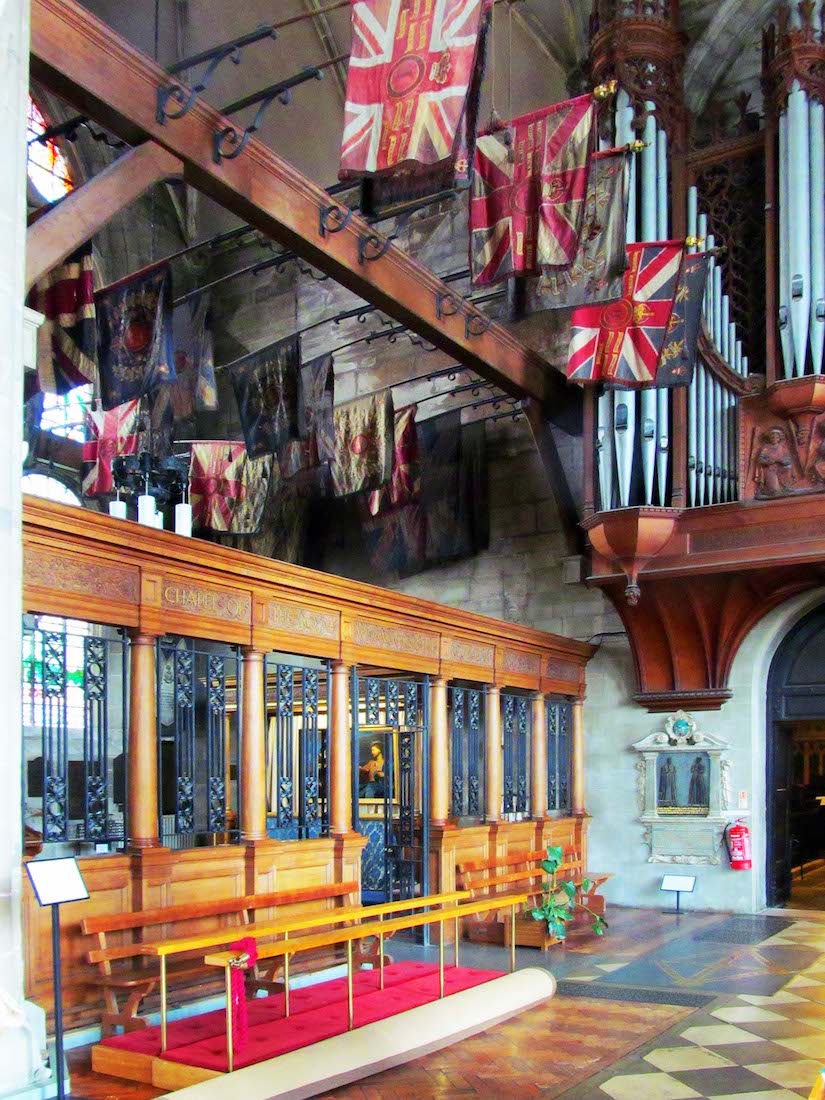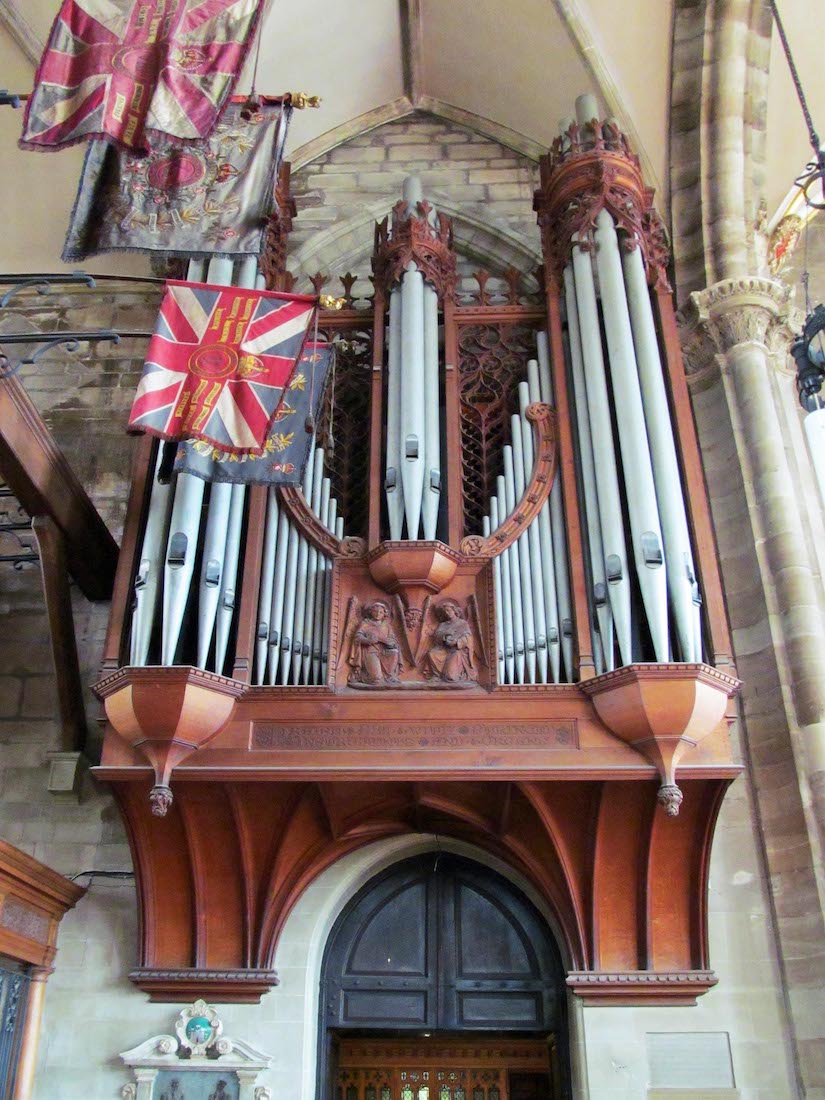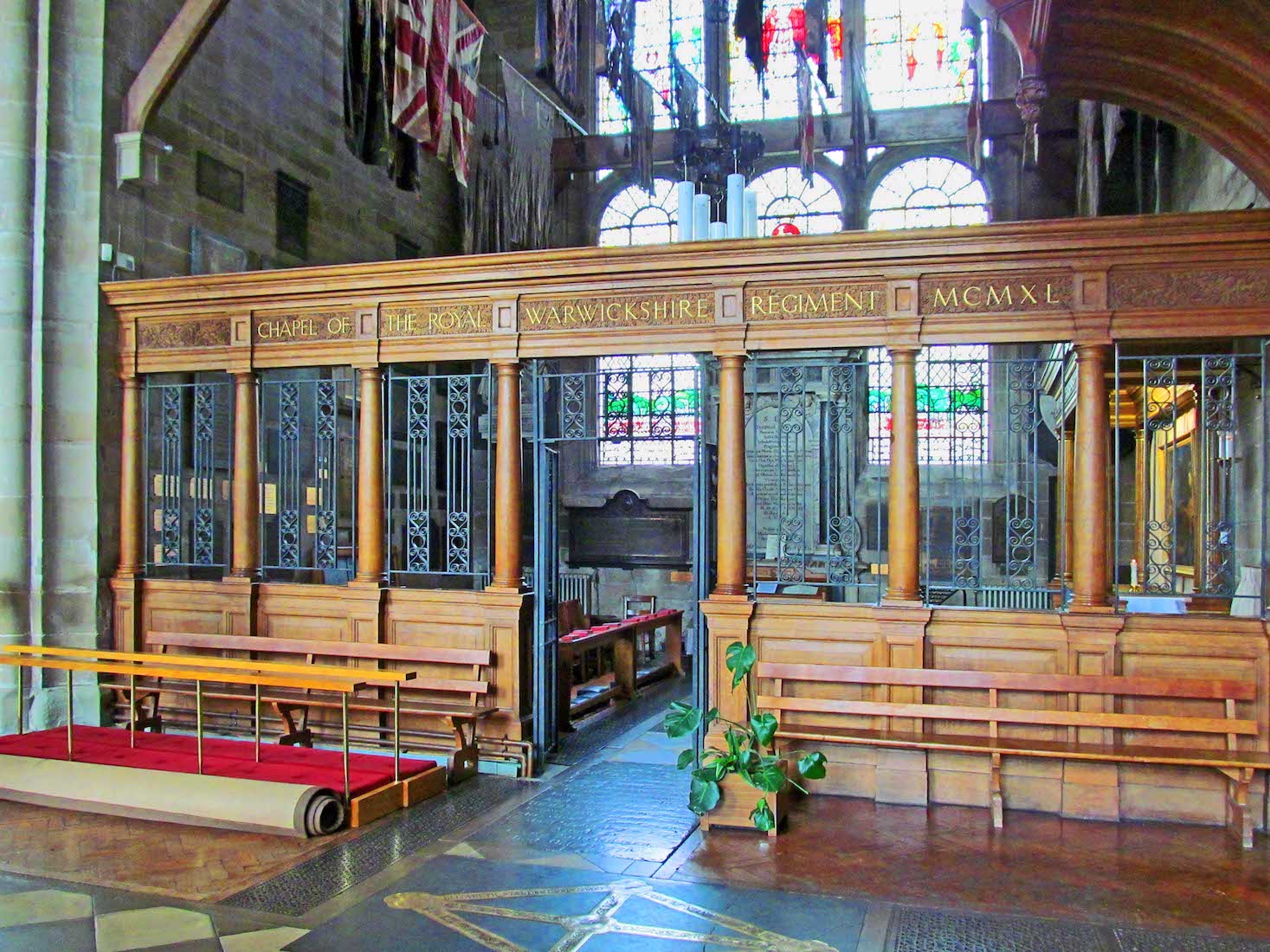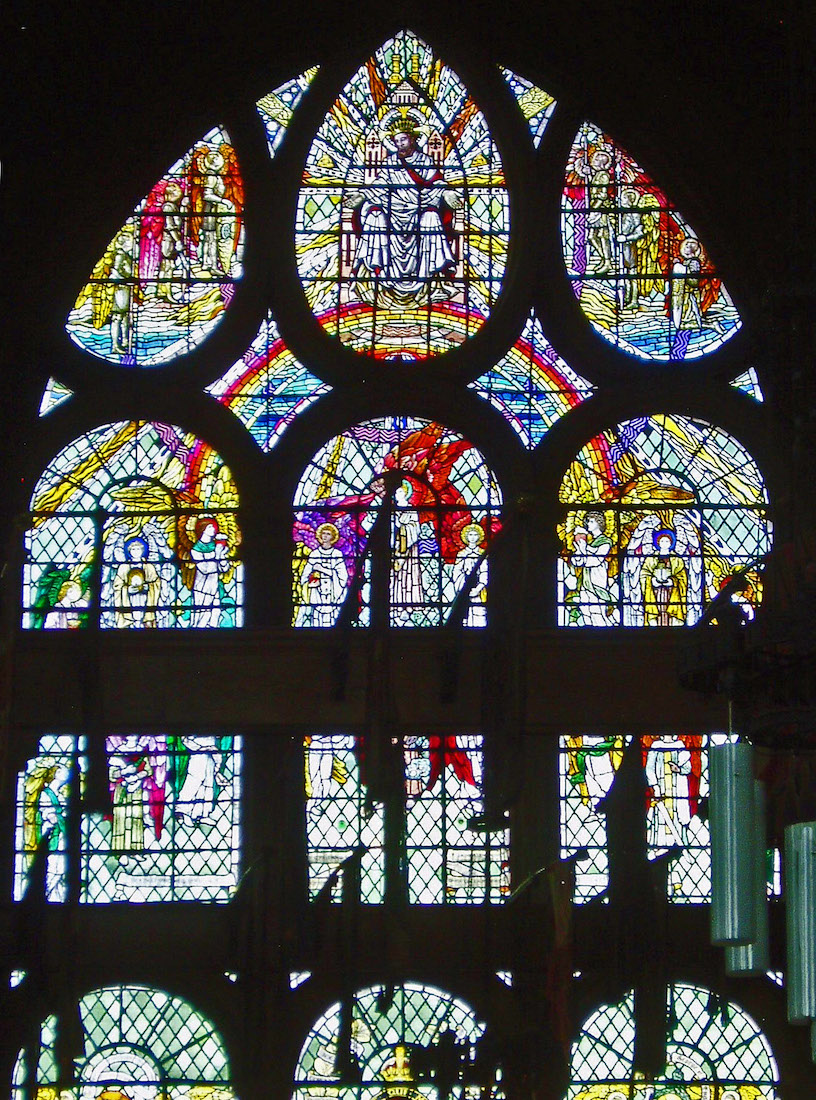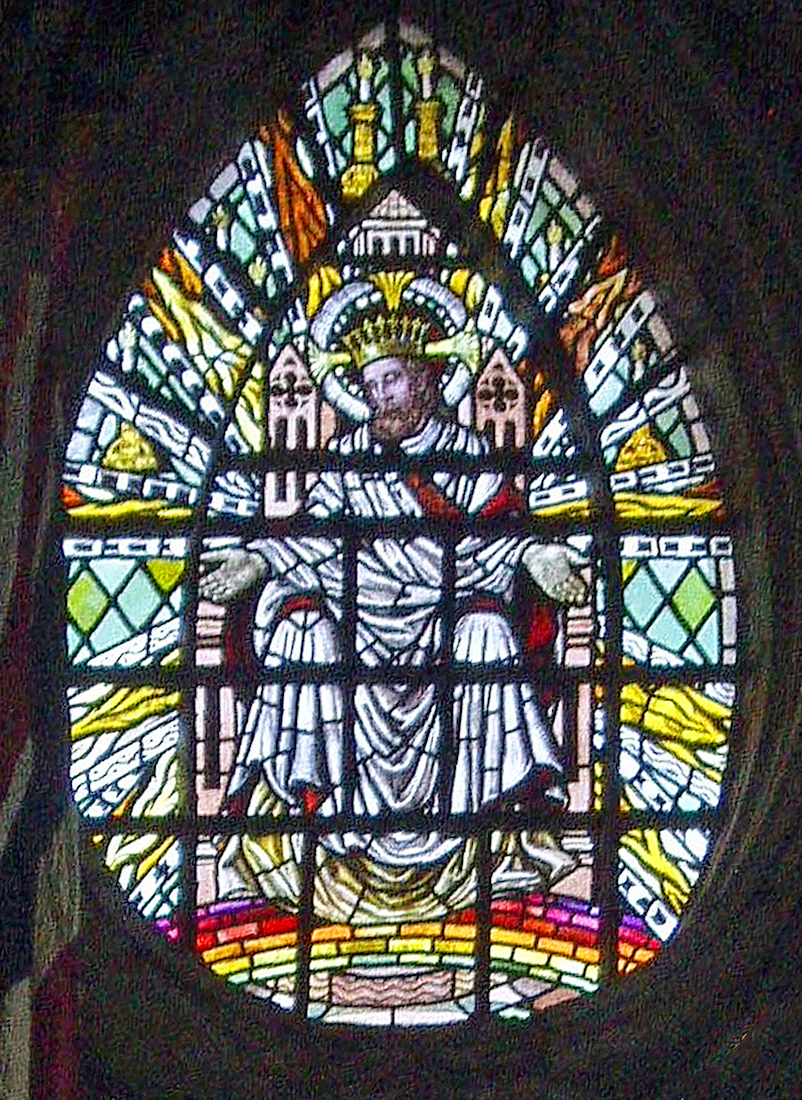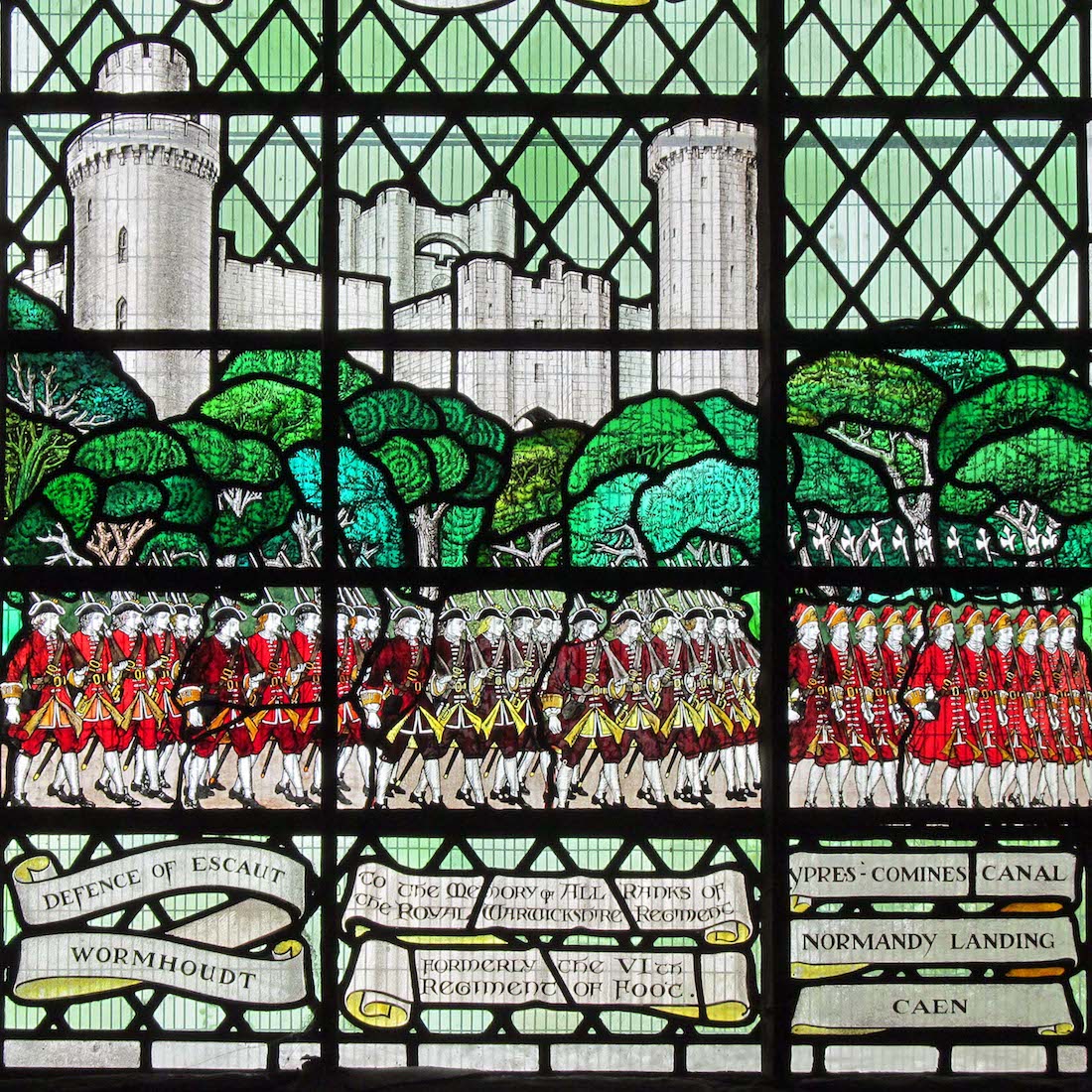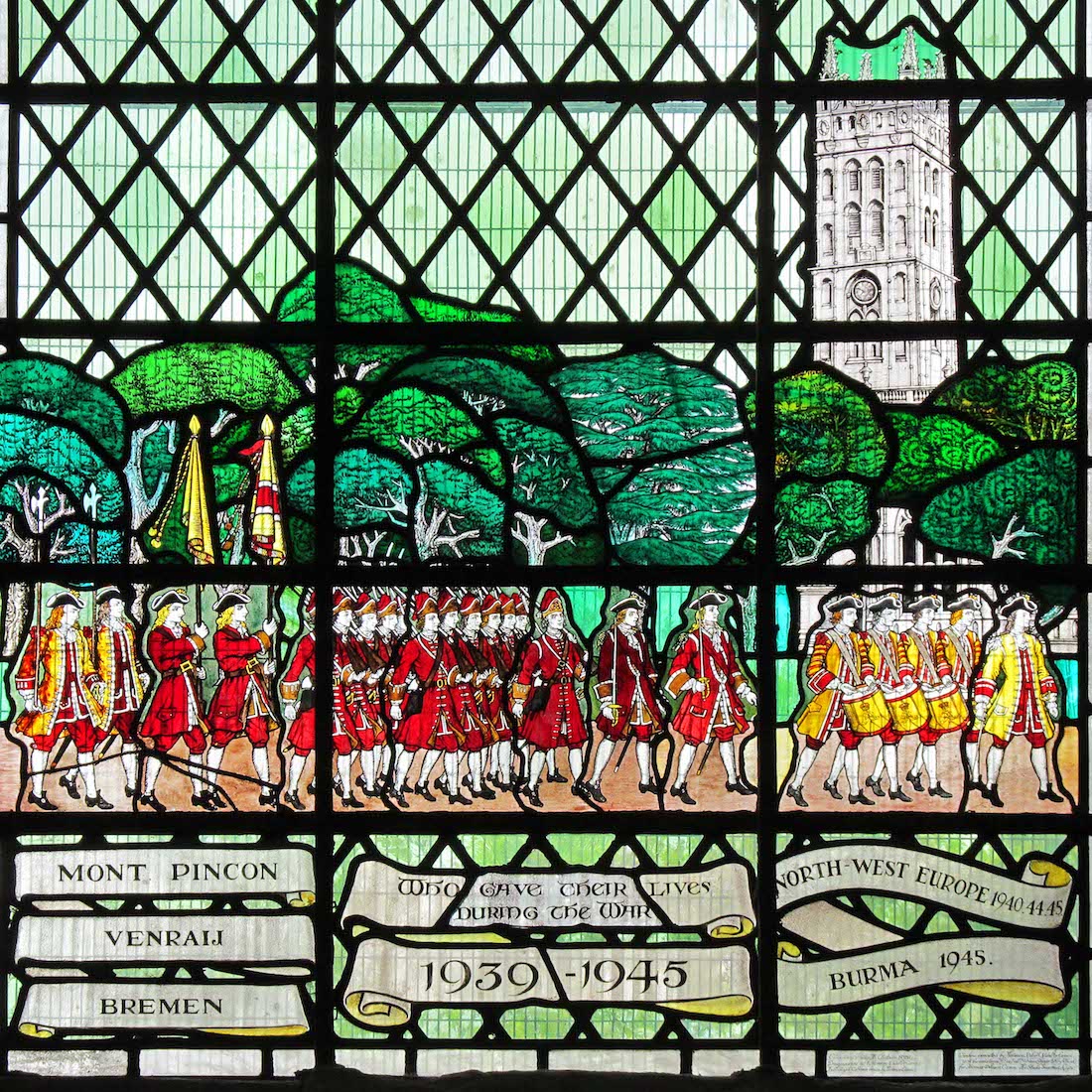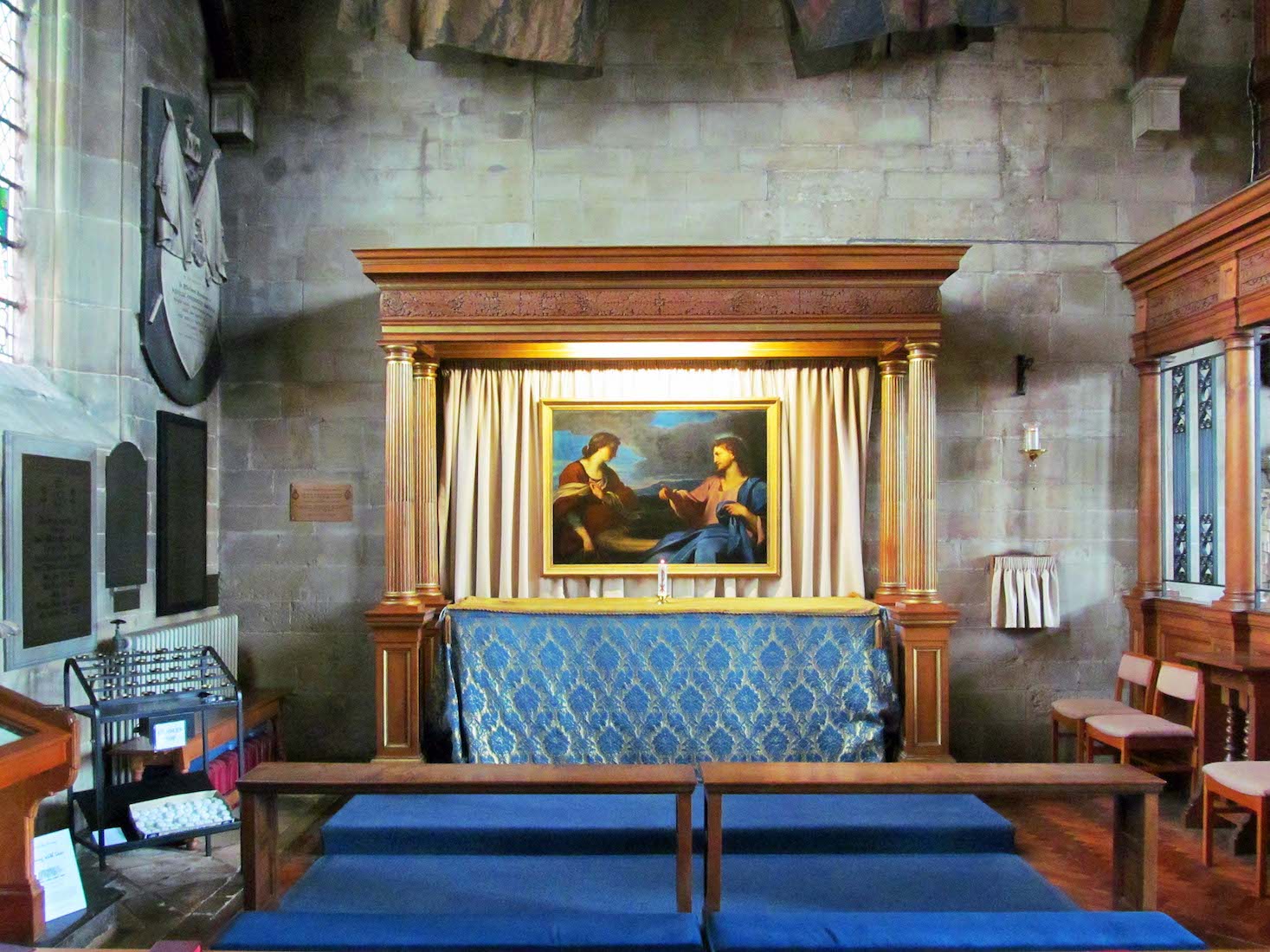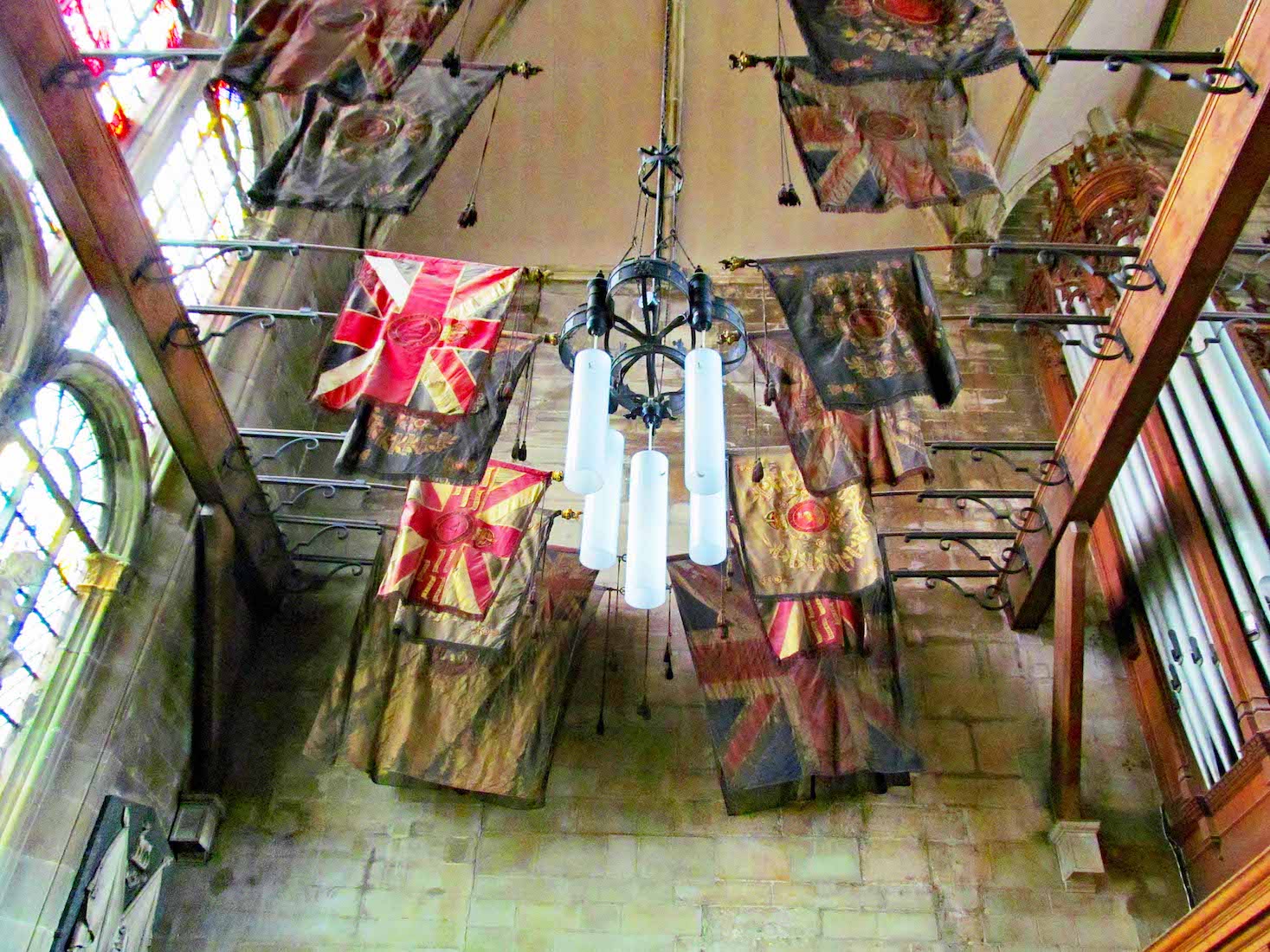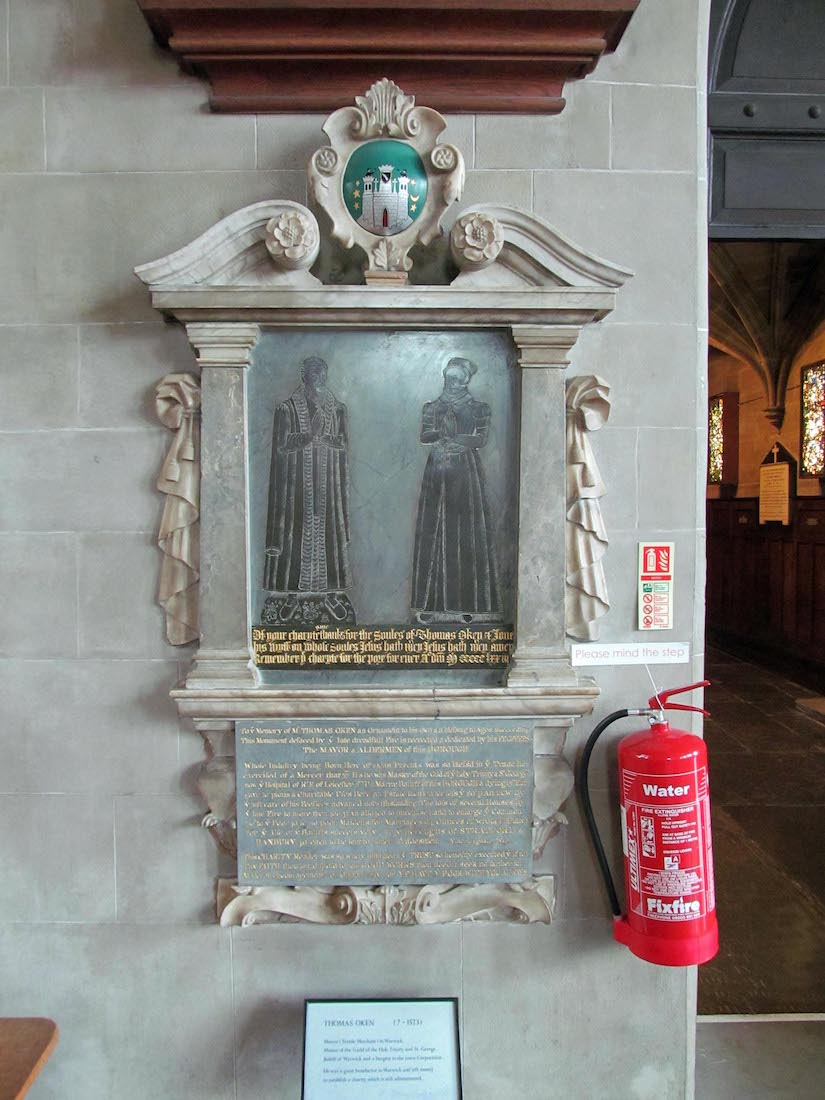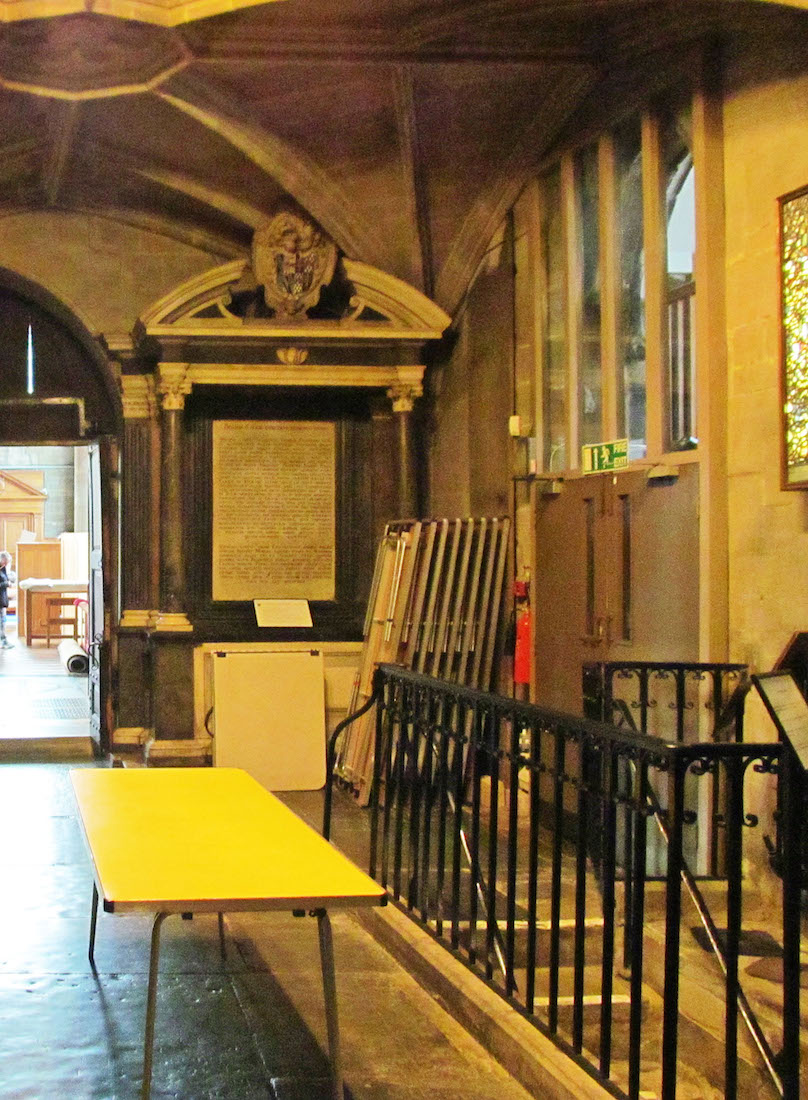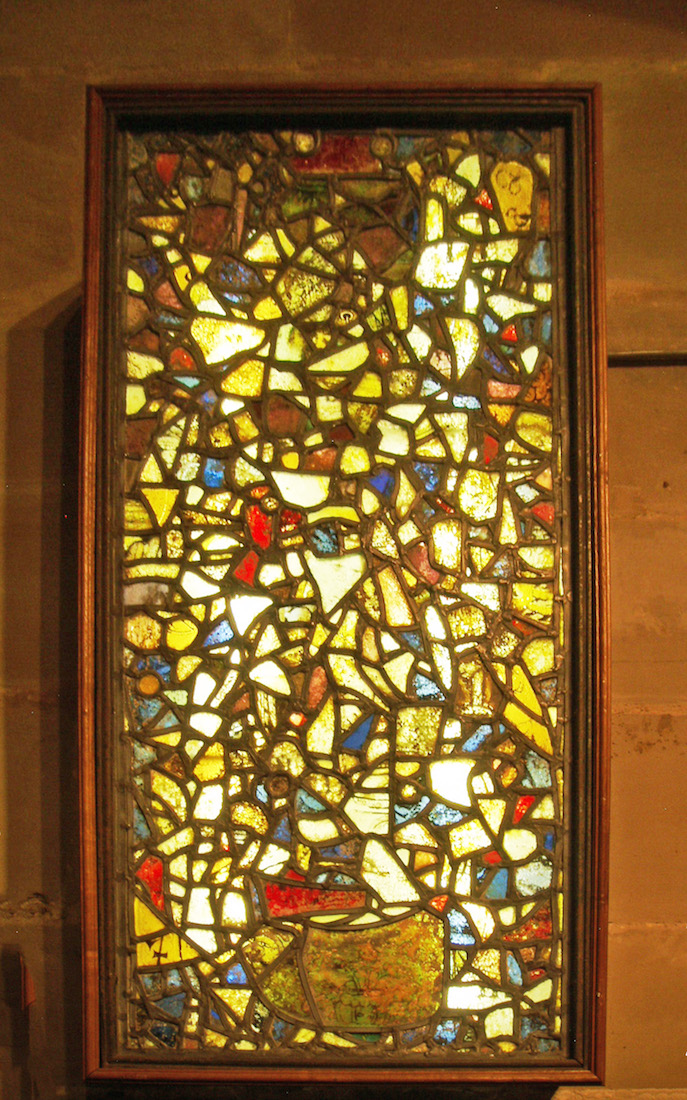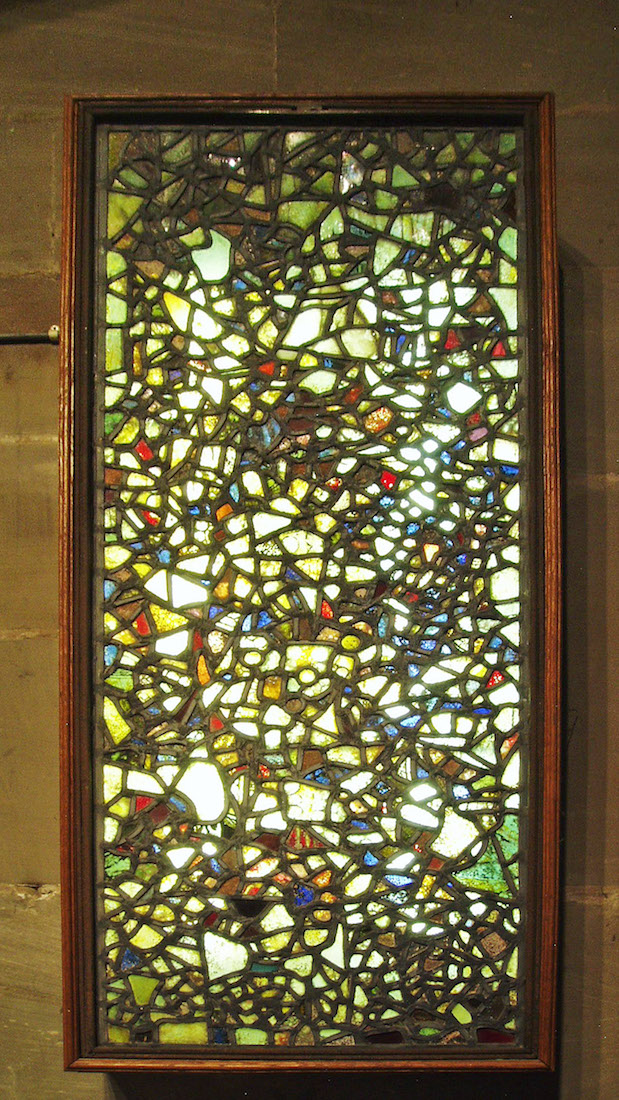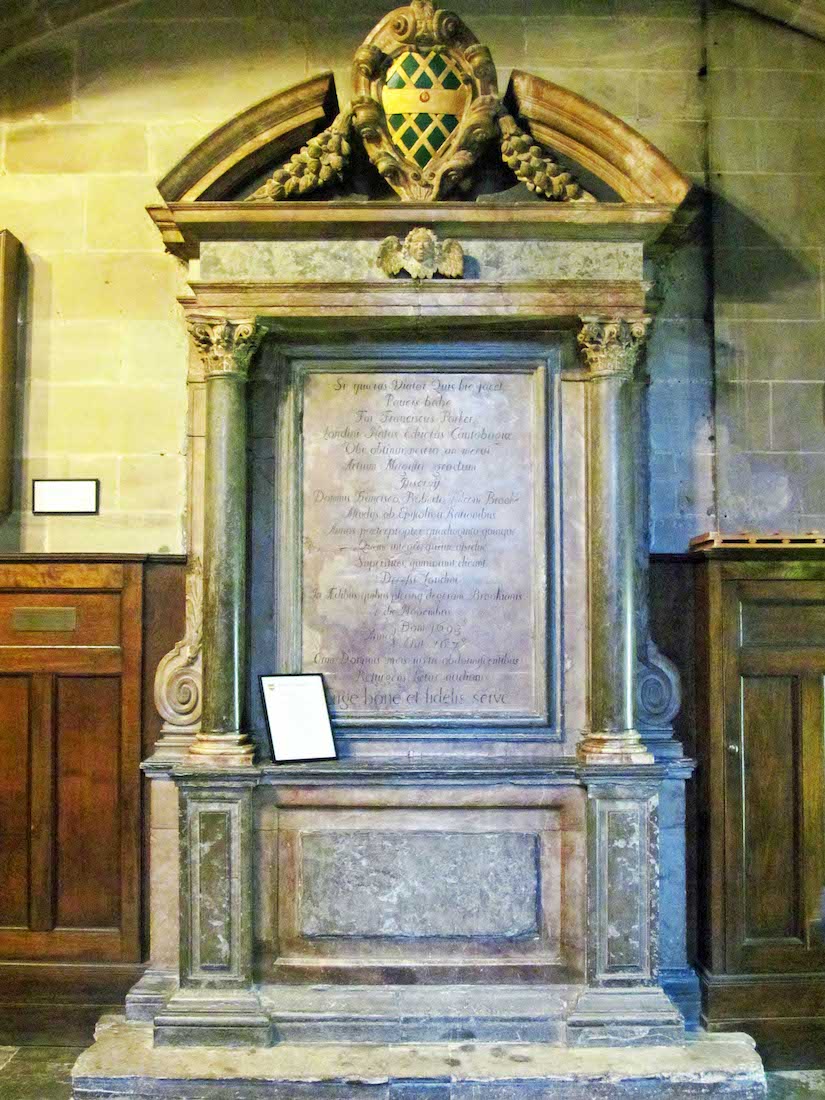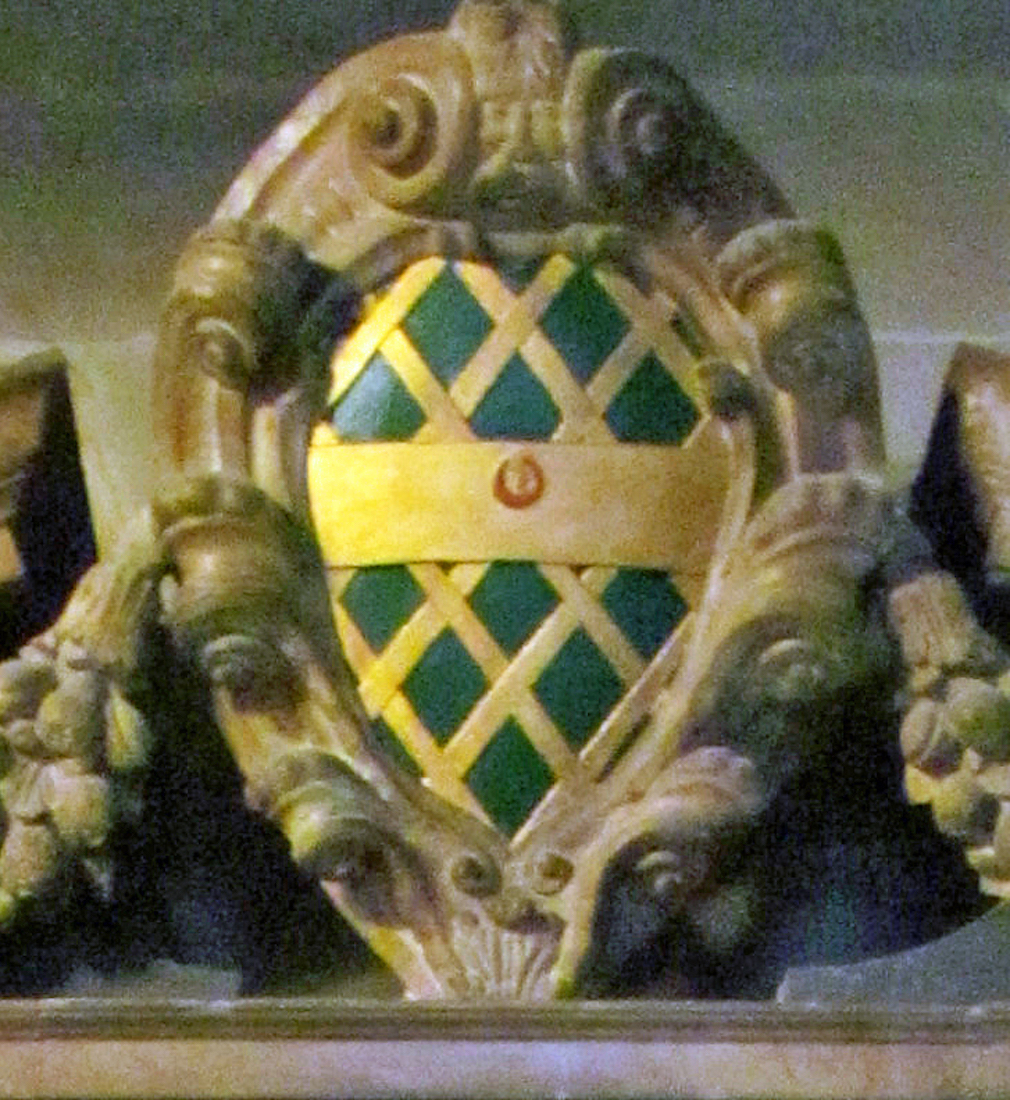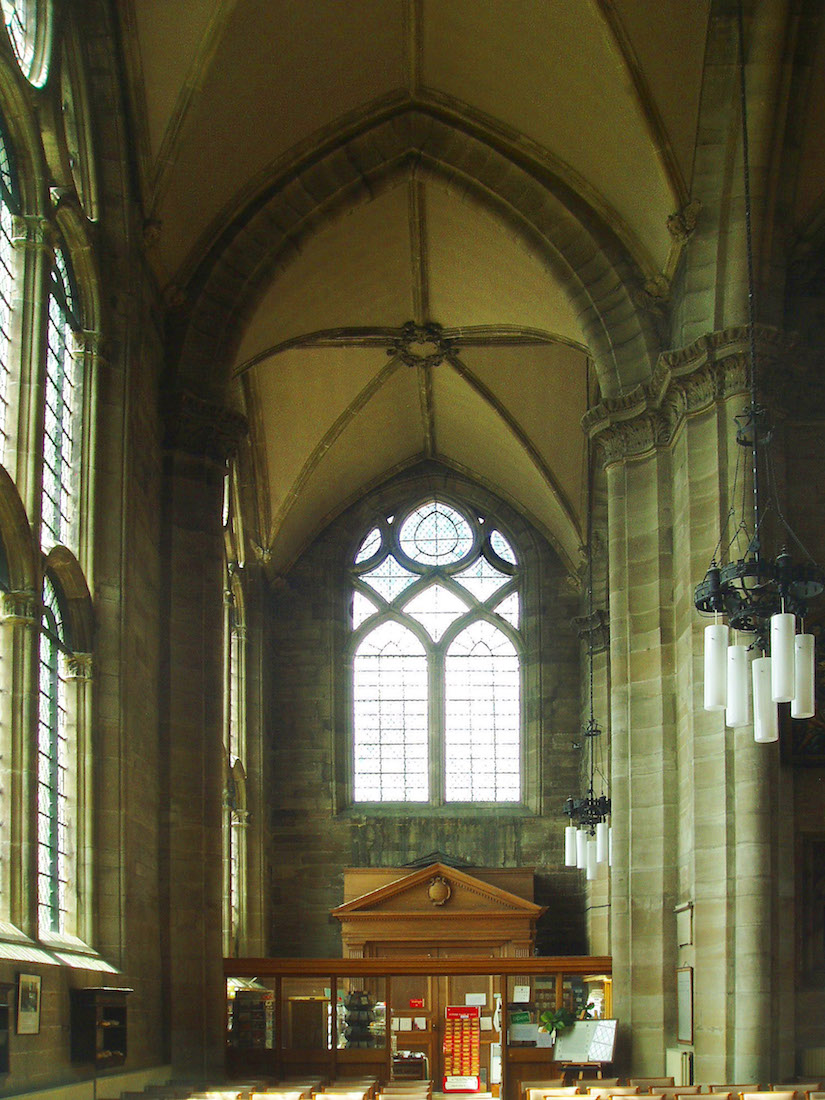
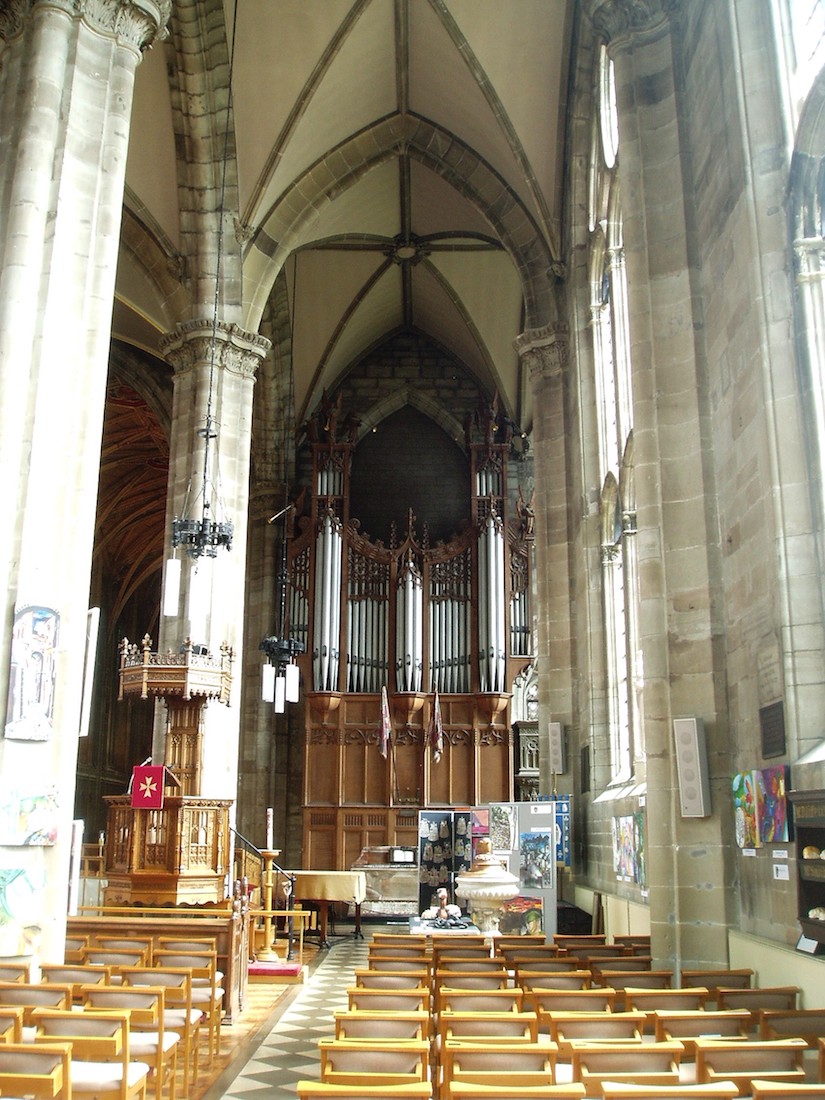
We now move across to the South aisle of the nave. Looking West (left view) we see that the Southwest corner of the Church has been converted into a shop. Behind the shop is a pair of doors leading to the street – only used in case of emergency! The right view shows the font, the pulpit, and another pipe organ. Also, on the wall at extreme right we catch sight of some curious bread shelves. INDEX
22. BREAD SHELVES WH
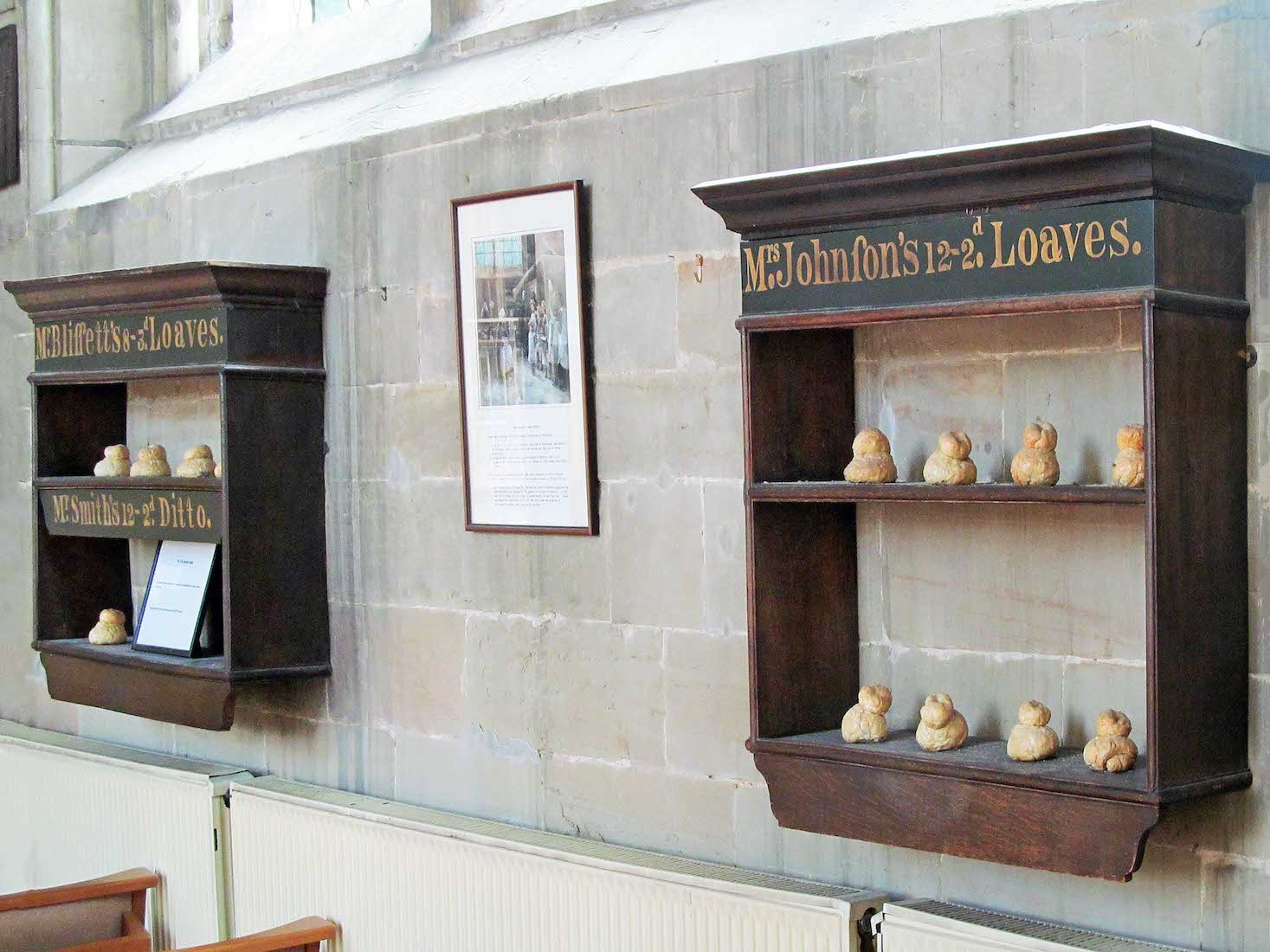
Joseph Blissett was a woollen draper and twice Mayor of Warwick who died in 1713; he left money in his will to distribute eight threepenny loaves each Sunday to poor people who lived in the parish of St Mary. Distribution had ceased by the 1960s and the remaining funds became part of the Warwick ‘Relief in Need’ charity (which combined the resources of 21 small charities in 1976). Bread was, however, distributed briefly again in 1978 and 1979. ...
23. SHELF DETAILS WH
... (Rev) John Smith was born in Warwick in 1562 and served as vicar of Sherbourne for 37 years. He left money in his will of 1624 for the poor of the parishes of St Mary and St Nicholas. The funds were used to purchase bread, clothing and shoes for the poor. His name appears on the bread rack (which was presumably constructed some time after 1711). After the distribution of bread ceased this charity also became part of the ‘Warwick Relief in Need’ charity. • Ann Johnson, the widow of a Warwick physician, died in 1733 at the age of 84. She left her estate for the benefit of the poor of Warwick. This charity joined with two others to form the Warwick United Charities in 1907. Bread was distributed until 1926 when money for the elderly was substituted.
24. FONT AMT, WH
Near the front of the South nave aisle stands the baptismal font – in Baroque style with an acanthus leaf stem. Christians regard baptism as an initiation rite into the Church, and in fact as a sign of entering the Christian life. Behind the font is a Mothers’ Union banner, and, by the window, a statue of Madonna and Child.
25. MADONNA AND CHILD WH
Jesus Christ is the focus of Christianity, so there is great interest in his birth and growing up, and so in his parents. Many sermons have been preached on th Virgin Mary, the circumstances of the birth of Christ, and of Mary’s example to mothers of today.
26. FRONT OF NAVE WH
As we stand at the front of the nave, we notice the silver organ pipes to left and right, the pulpit and Paschal candle at right, a ‘special’ front seat, and the lectern at left. A modern set of choir stalls fills the space at centre.
27. EAST ORGAN WH
Shown here is the set of organ pipes at the end of the South aisle. In 1897 Robert Hope-Jones was invited to provide a new organ to supersede the organ in the West gallery. This was one of the first organs in the country to have electro-pneumatic action. It had a four-manual console, some thirty-six speaking stops, and was spread over the church in four separate cases – one in the chancel, one each on the Northeast and Southeast transept walls, and a small part in the old Schwarbrick West case. This organ lasted for almost another hundred years, tonal adjustments and additions being made by Norman and Beard (1918), Compton (1928) and a more substantial rebuild in 1966 by the Northampton firm of Alfred E. Davies and Son Ltd. • Below these pipes is an altar to ‘The Glorious Dead’.
28. BOOK OF REMEMBRANCE WH
On this altar is a Book of Remembrance containing the names of members of the Royal Warwickshire Regiment who died in the First World War. So many ... .
29. PULPIT WH
The delicately carved pulpit bears the name ‘The Provincial Grand Master Lord Leigh’. William Henry Leigh, 2nd Baron Leigh, PC, JP (1824 –1905) was a British politician. He was the first Grand Master of the Grand Lodge of Mark Master Masons, serving from 1856 to 1860. He was for more than 50 years (1852–1905) Provincial Grand Master for the Freemasons of Warwickshire. It appears that the pulpit was given by him, or given in memory of him.
30. SELECT SEAT WH
We notice that the front aisle seat on the South side is set apart for a ‘special’ guest. This often happens in cathedrals and major churches which may be visited by a member of Royalty, Government, or the Church hierarchy.
31. LECTERN WH
A fine eagle lectern stands at the front of the North side of the nave. It is from here that the Scripture is read on a Sunday. There is a long tradition of eagle lecterns, but I suspect that the reason for the choice of eagle relates to the verse Isaiah 40:31 : ‘but those who trust in the Lord will renew their strength; they will soar on wings like eagles; they will run and not grow weary; they will walk and not faint.’
32. REGIMENTAL CHAPEL AND ORGAN WH
The shallow North transept is occupied by the Regimental Chapel which we will investigate next. But we notice some more organ pipes! The present organ arrangement was drawn up by the organist, Andrew Fletcher, in consultation with Roy Massey, and was built by the firm of Nicholson and Co. Ltd. of Worcester in 1980. The aim was to produce an instrument well able to serve all the needs for accompanying the very fine Collegiate Church Choir and also to be a very versatile recital instrument. The result is effectively two fine organs played from one console in the nave. The two-manual transept organ is now contained entirely in the Northeast case visible here, (although the empty chancel and Southeast cases remain in church to this day). This organ retains much of the old Hope-Jones pipework and is most English in character, whereas the West organ, in the enlarged Schwarbrick case, is a neo-classically voiced three-manual organ ideally suited to the demands of the European organ schools. Both organs can be played singly, or used together to great effect.
33. REGIMENTAL CHAPEL WH
We turn our attention to the North transept which is occupied by the Chapel of the Royal Warwickshire Regiment. This Regiment is one of the oldest regiments in the British army. It was previously titled the ‘6th Regiment of Foot’, a line infantry regiment of the British Army in continuous existence for 283 years. The Regiment saw service in many conflicts and wars, including the Second Boer War and both the First and Second World Wars. On 1 May 1963, the Regiment was re-titled, for the final time, as the Royal Warwickshire Fusiliers and became part of the Fusilier Brigade.
34. CHAPEL WINDOW AMT
The RWR Chapel was established in the Collegiate Church of St. Mary after WWII and features a stained glass window by Philip Chatwin honouring those from the regiment who had given their lives in war. In 1952 the Regimental Chapel was dedicated by the then Chaplain General and the stained glass window was unveiled in 1952 by Field Marshal the Viscount Montgomery of Alamein. The window is very large and dominates the Chapel.
35. MARCHING SOLDIERS! WH
Across the bottom of the window are two panels depicting the Royal Warwickshire Regiment marching in front of Warwick castle. The central panel is blocked by a memorial remembering Thomas Hewitt who served with the Regiment..
36. CHAPEL ALTAR WH
The North transept is setup as a chapel, with several rows of chairs facing this altar set against the East wall. The painting above the altar is attractive, but I have not been able to determine the subject matter.
37. COLOURS AND OKEN MEMORIAL WH
Above us hang the many Regimental colours associated with the Warwickshire Regiment: it is a world-wide custom for the colour of disbanded regiments to be displayed in cathedrals and churches. As we leave the Chapel, we pass a wall memorial toThomas Oken who died in 1573, and his wife Joan. At the time that Warwick was granted its town charter in 1545, Thomas Oken was a mercer and master of a guild. Oken may have been the richest man in Warwick; he made his fortune dealing in wool and woven fabrics. He was a great benefactor to Warwick.
38. VESTRY WH
We walk through the doorway under the East organ into an area called ‘the vestry’, although really this name only applies to the East end. From here, looking back out into the nave, we have from left, two framed displays of old glass fragments, two large monuments, and at right a set of steps leading down to the crypt.
39. MEDIEVAL FRAGMENTS AMT
In this vestry area are four wall-mounted illuminated stained glass panels composed entirely of fragments of medieval glass originating from either the chancel or Beauchamp Chapel windows The fragments are rather heavily weathered and it is difficult to discern many details, beyond scraps of figures and foliate patterns.
40. PARKER MEMORIAL WH
Between the previous medieval fragments and the entrance stands this memorial to Francis Parker dating from 1693.


